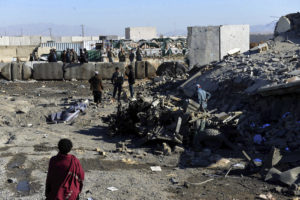Fabricated Evidence, Round Two?
The writers explain why a pre-emptive attack on Iran would backfire, and they challenge the Bush administration's claims that Iran is supplying explosives to Iraqi insurgent groups.Reese Erlich and Muhammad Sahimi In recent weeks the Bush administration has launched a propaganda blitz accusing Iran of helping Shiite militias murder American soldiers in Iraq. On Feb. 11, U.S. military officials in Baghdad presented an elaborate display of rocket-propelled grenades, mortar rounds and components for explosives that they said were responsible for the deaths of 170 GIs over the past three years. They claimed that such weapons were made available to the insurgents with the approval of the highest authorities in Iran. These accusations are eerily similar to the administration’s claims in 2002-2003 that Saddam Hussein possessed weapons of mass destruction and that his regime had connections with al-Qaida.
Upon close inspection, however, the United States’ claims seem dubious at best. American officials have stated that Iran provides key components for explosively formed penetrators (EFPs) that can blow up armored Humvees. Such devices require precision machining that cannot be done in Iraq, according to U.S. officials. However, EFPs were, in fact, first developed by the Irish Republican Army in its fight against Britain. They were also used by the German Red Army in 1989 to murder the German banker Alfred Herrhausen. The Pentagon has been producing EFPs since 1977. They are commercially available for mineral mining, and have been used for years by guerrilla groups in the Middle East.
These supposed precision parts can be manufactured in many Iraqi machine shops. There are a large number of unsecured caches of munitions spread throughout Iraq. All one needs are small-diameter iron pipes, a fuse and a metallic bowl. The use of EFPs in Iraq is also not new. They have been used almost from the beginning of the insurgency.
The mortars that are known to be produced by Iran have four horizontal ribs below the lettering, while those shown by the U.S. military in Baghdad have three ribs above the lettering. The Iranian type does not usually have dates, but those shown by the U.S. do have them, and Iraq has produced them since at least the 1991 Persian Gulf War. Moreover, the U.S. military has not explained why rocket-propelled grenades that were supposedly manufactured in Iran were dated American style (for example, 5/31/2006) and not in the style used in Iran and Europe (31-5-2006). It is also known that explosives manufactured for domestic use in Iran use the Iranian, not the Christian, calendar.
Military briefers also alleged that Iran’s weapons were responsible for “a significant portion” of the U.S. casualties in Iraq during the last quarter of 2006. The estimate itself appears to be vastly exaggerated, but even if true, the 170 fatalities represent less than 7 percent of the total U.S. losses in Iraq. Thus, even if all of the alleged weapons smuggling stopped tomorrow, the U.S. would not face significantly fewer casualties in Iraq.
The vast majority of American casualties have been caused by Sunni insurgents, funded by wealthy individuals from Middle Eastern nations allied with the U.S., such as Saudi Arabia. Far fewer Americans have been killed by Shiite militias, who were helped into power by the U.S. and who are now allegedly supplied by Iran.
Even if some weapons do come from Iran, Gen. Peter Pace, chairman of the Joint Chiefs of Staff, admits that the U.S. can’t directly link the shipments to Iranian leaders. Iranian weapons, like those manufactured in the U.S., can be sold on the black market. The U.S. faces serious problems of its own because its weapons are regularly sold illegally. Recently, the Pentagon banned sales of spare parts for F-14 fighter jets because they were ending up in the wrong hands. The problem got so bad that the Pentagon had to destroy a very large inventory of parts.
The U.S. propaganda about Iran’s alleged meddling in Iraq follows years of a similar misinformation campaign about Iran’s plans to build nuclear weapons. For years the United States has supplied the International Atomic Energy Agency supposedly solid intelligence on Iran’s nuclear program, and the IAEA has duly pursued the leads.
A good example is a supposedly stolen laptop computer discovered in 2005 that contained secret designs for nuclear weapons. Why anyone would store such information on a laptop was never questioned. Why all the designs were in English, rather than Persian, was also not questioned. Why the laptop would be in a place where it could be stolen was not addressed, and how one could smuggle it out of Iran and escape Iran’s intelligence services, considered one of the best in the Middle East, was not also investigated. A second example is Iran’s Parchin site near Tehran, where conventional munitions have been produced for at least 40 years. The U.S. claimed that Parchin may be the site where the munitions for triggering a nuclear reaction in a bomb are made.
It now appears that all such claims are either completely false or vastly exaggerated. The IAEA’s 2005 inspection of Iran’s nuclear sites, including the Parchin site, has not led to any credible evidence that indicates the existence of a secret nuclear weapon program. The fact is that most such claims, if not all, have been made to the U.S. by the Mujahedeen-e-Khalq (MEK), an armed Iranian opposition group that has been listed by the State Department as a terrorist group. MEK was used by Saddam Hussein to suppress the Shiite and Kurdish uprisings in Iraq and is supported by American neoconservatives.
Why did the Bush administration intensify the propaganda campaign at this particular time? The president and members of his administration insist publicly that the U.S. does not intend to attack Iran militarily. There are, however, very strong indications to the contrary, ranging from ratcheting up the rhetoric against Iran to dispatching a second aircraft carrier group to the Persian Gulf.
American neoconservatives and armchair warriors have been claiming that intense bombing of Iran would lead to an uprising by Iranians. The absurd argument is that although the bombs will destroy parts of Iran, Iranians will love the U.S. for bombing them and hate the hard-line government leaders. But the reality is vastly different from such fantasies.
Although a large majority of Iranians despise the hard-liners, anyone who has the slightest familiarity with Iran’s history knows that military attacks on Iran would not lead to their downfall. Iranians would rally round their government, just as Americans did after Sept. 11. Thus, the attacks would help the hard-liners consolidate power. As Mohammad Reza Khatami, a leader of Islamic Iran Participation Front (Iran’s largest reformist party) and the younger brother of Iran’s former reformist president, said, “The conservatives need an external enemy in order to preserve their power.”
In addition, a U.S. attack on Iran would violate not only the United Nations Charter but also the Algiers Accord, signed in 1980 to end the hostage crisis. That accord states, “The United States pledges that it is and from now on will be the policy of the United States not to intervene, directly or indirectly, politically or militarily, in Iran’s internal affairs.”
Part of the administration’s propaganda against Iran is sold to the public under the guise that the U.S. wants freedom and democracy for the Iranian people. But according to Shirin Ebadi, the Nobel Peace Prize-winning Iranian human rights advocate once imprisoned by Iran’s hard-liners, “Democracy cannot be imported, nor can it be given to a people by invading their nation, nor by bombing them with cluster bombs. It must be indigenous.” She has also declared, “Iranians will not allow a single U.S. soldier to set foot in Iran.”
The U.S. military strikes would come precisely at a time when President Mahmoud Ahmadinejad is losing popularity, as Iranians recognize the danger in his rhetoric and his failure to improve Iran’s economy. In December, university students forced him to stop a speech by shouting “Death to the dictator.” The Iranian parliament, in which his supporters are supposed to form a large majority, has severely criticized him for both his domestic and foreign policies. In recent municipal elections, candidates backed by Ahmadinejad received only 4 percent of the vote.
Ebrahim Yazdi, a leading opposition figure in Tehran, told us in a recent interview: “The U.S. does not understand Iran. By threatening possible military action, the Bush administration tosses a lifesaver to the Iranian government.” He continued, “Iranians went through that experience once when the CIA overthrew the democratic government of Mohammad Mossadegh in 1953 and installed the brutal dictatorship of Shah Mohammed Reza Pahlavi.”
Given such sentiments, the worst thing that the U.S. can do is attack Iran. Military strikes would set off the potent mixture of Iranian nationalism with Shiites’ long-held belief in martyrdom in defense of the homeland and religion. The attacks, and Iran’s response to them, would engulf the entire region in fire.
The U.S. must stop beating the drums of war and enter into immediate negotiations with Iran to resolve disputes over Iraq, Iran’s nuclear power program and other outstanding issues. As the Shanghai Communiqué, which was issued Feb. 28, 1972, and signed by President Richard Nixon and Chinese Premier Zhou Enlai and which re-established diplomatic relations between the U.S. and China, said:
There are essential differences between China and the United States in their social systems and foreign policies. However, the two sides agreed that countries, regardless of their social systems, should conduct their relations on the principles of respect for the sovereignty and territorial integrity of all states, non-aggregation against other states, non-interference in the internal affairs of other states, equality and mutual benefit, and peaceful coexistence. International disputes should be based on this basis, without resorting to the use or threat of force.
The U.S. should pursue negotiations with Iran based on exactly the same principles.
Your support matters…Independent journalism is under threat and overshadowed by heavily funded mainstream media.
You can help level the playing field. Become a member.
Your tax-deductible contribution keeps us digging beneath the headlines to give you thought-provoking, investigative reporting and analysis that unearths what's really happening- without compromise.
Give today to support our courageous, independent journalists.



You need to be a supporter to comment.
There are currently no responses to this article.
Be the first to respond.